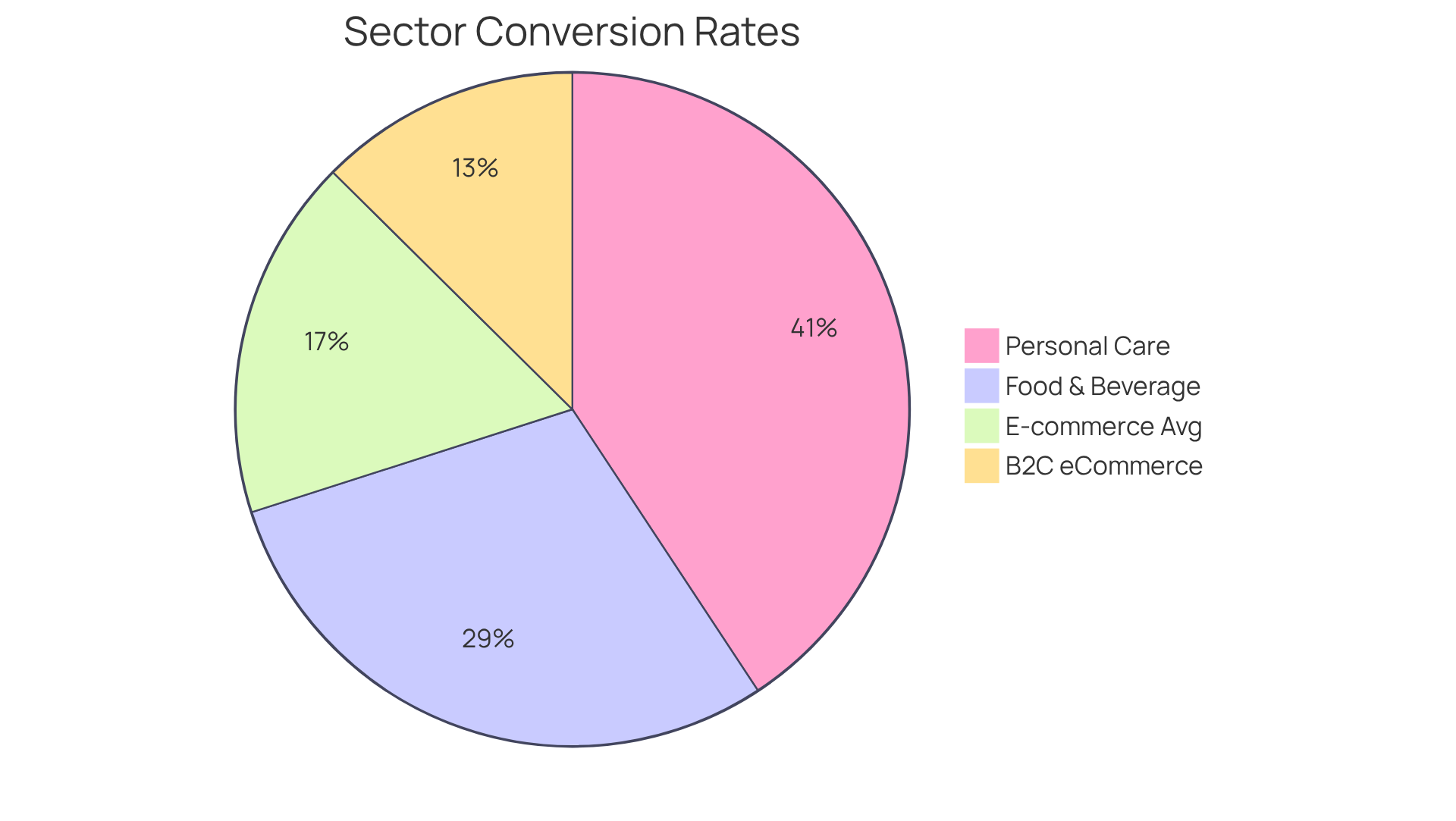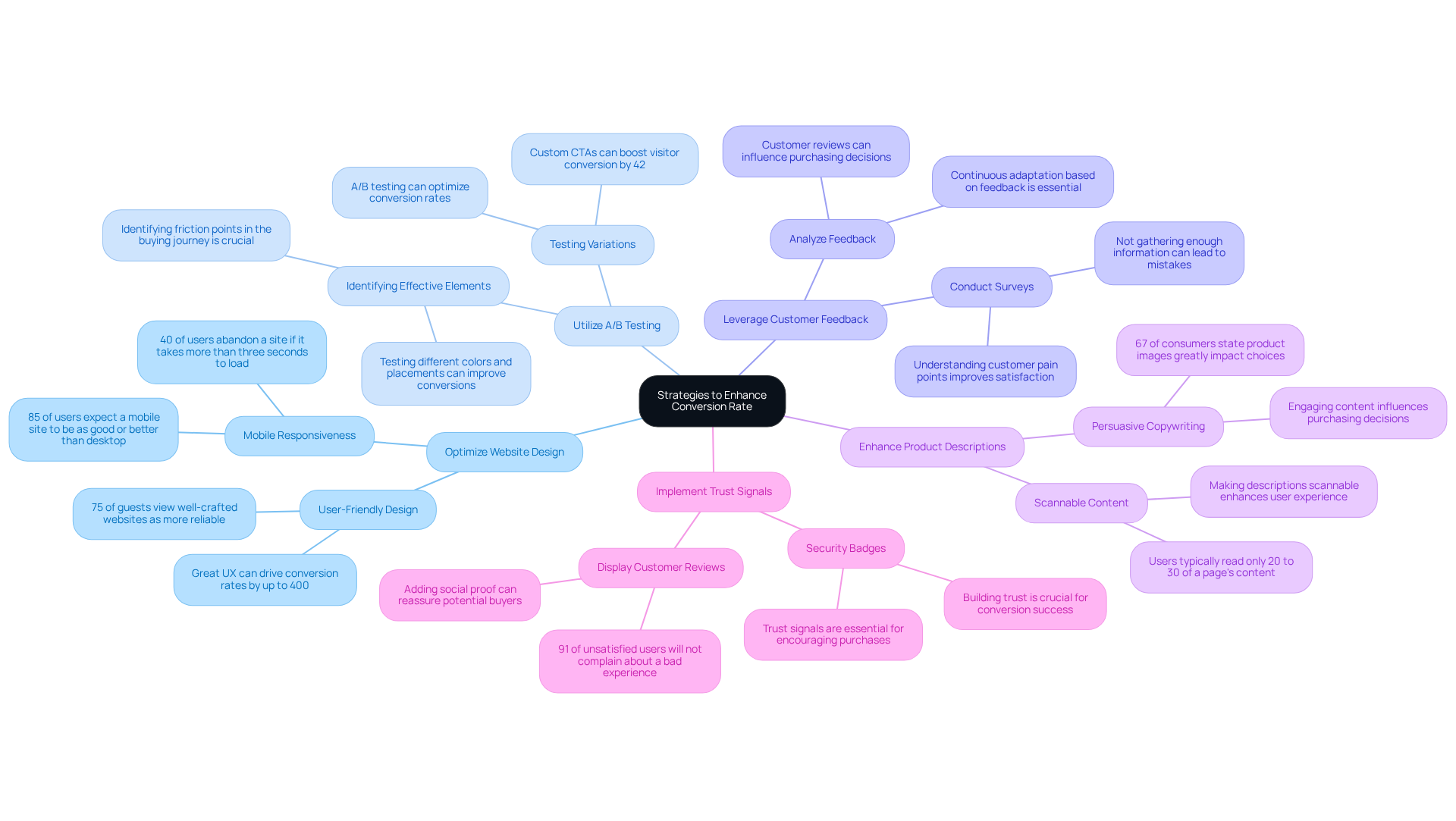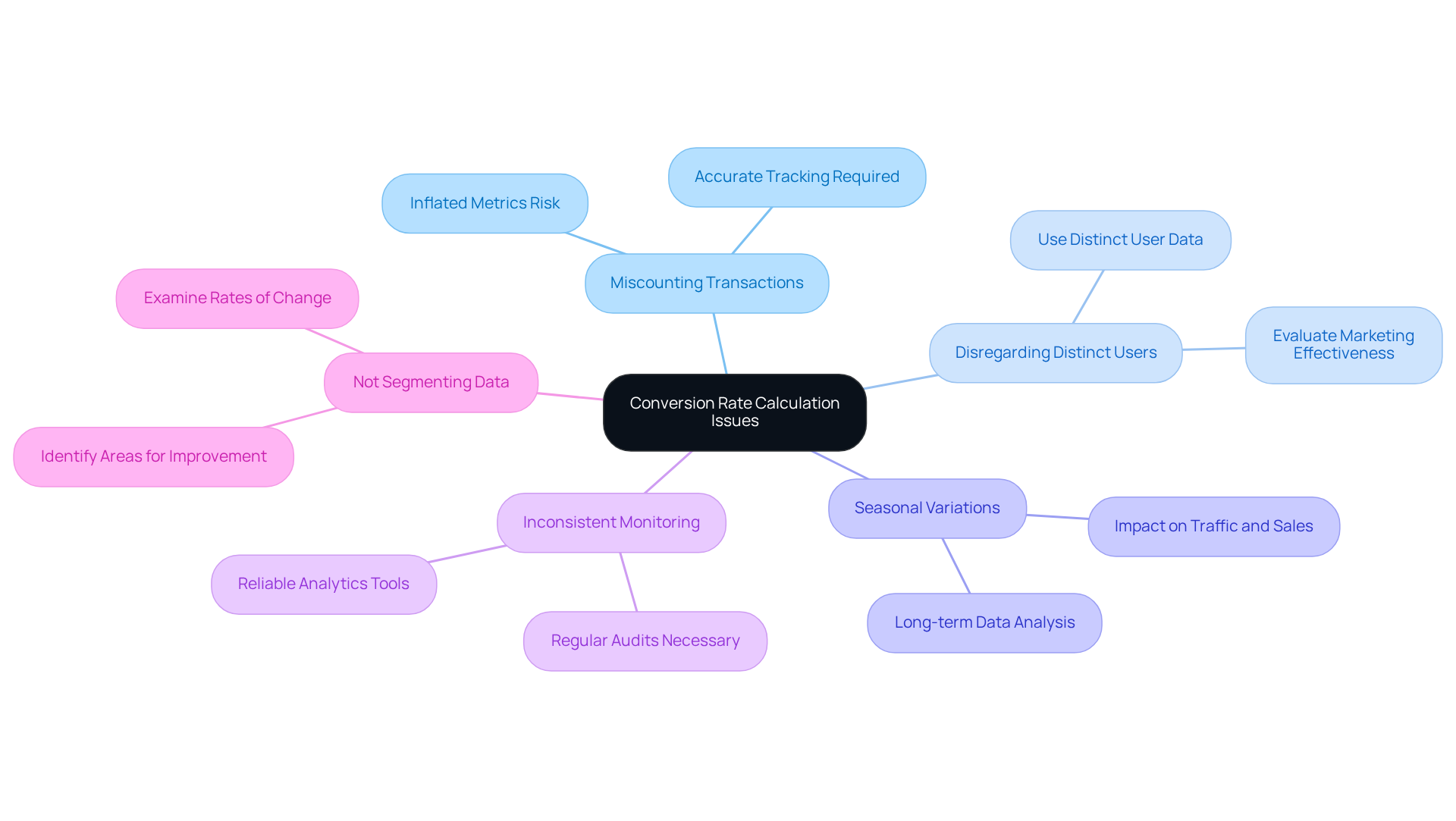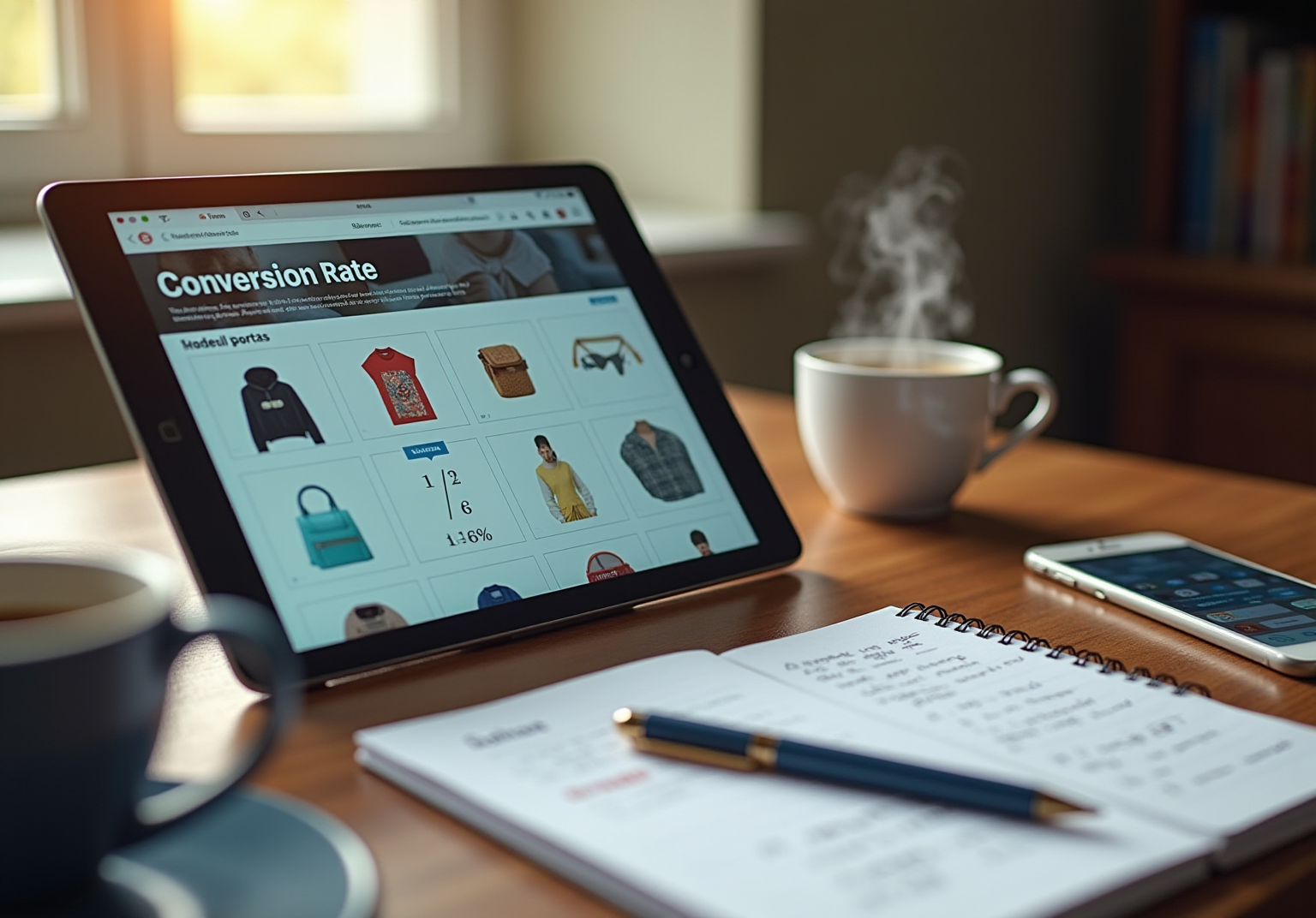
Overview
Understanding conversion rates is vital for direct-to-consumer (DTC) brands aiming to measure their sales effectiveness and profitability. By calculating these rates, brands can gain insights into customer behavior and optimize their marketing strategies. This knowledge not only enhances customer engagement but also drives increased sales.
To achieve this, brands should implement several key strategies:
- A/B testing allows for the comparison of different marketing approaches, helping to identify what resonates best with customers.
- Website optimization ensures that the user experience is seamless, encouraging visitors to complete their purchases.
- Leveraging customer feedback further refines these strategies, providing valuable insights into consumer preferences and pain points.
In conclusion, mastering conversion rates is not just about numbers; it’s about creating a more engaging and profitable customer journey. By focusing on these essential steps, DTC brands can significantly enhance their sales performance and build lasting relationships with their customers.
Introduction
Understanding the conversion rate is crucial for direct-to-consumer (DTC) brands that want to excel in a competitive marketplace. This essential metric not only indicates how effectively a website converts visitors into customers but also significantly impacts profitability, especially as customer acquisition costs continue to rise. Yet, many brands find themselves grappling with the accurate calculation and optimization of this rate. They often ask: what strategies can truly enhance their conversion rates and foster sustainable growth?
This article explores the fundamental steps for calculating conversion rates, highlights common pitfalls to avoid, and presents actionable strategies designed to elevate DTC success. By mastering these elements, brands can position themselves for long-term achievement in an ever-evolving landscape.
Define Conversion Rate and Its Importance for DTC Brands
Conversion percentage represents the proportion of visitors to your website who complete a desired action, such as making a purchase. For direct-to-consumer (DTC) companies, this metric is crucial as it directly correlates with profitability. A higher success ratio indicates greater sales from the same volume of traffic, which is essential in an environment where customer acquisition costs are on the rise. Understanding how to conversion rate calculate helps identify areas for improvement, which enables companies to optimize their existing resources effectively and enhance profit margins without incurring additional advertising expenses.
Typically, the e-commerce success percentage hovers around 2.9%, while B2C eCommerce averages at 2.1%. However, successful DTC companies often achieve significantly higher rates through effective optimization strategies. For instance, personal care products boast an impressive average success rate of 6.8%, while the food and beverage sector sees an average success rate of 4.9%. These figures indicate strong consumer interest and effective promotional efforts.
Moreover, industry experts highlight that the emotional impact of a product often outweighs its functionality. Seth Godin points out that the perception that price is all customers care about stems from a lack of compelling alternatives. This underscores the necessity for DTC companies to craft engaging user experiences that resonate with their audience. Notably, three out of four online shoppers have purchased a product influenced by an influencer's recommendation, further emphasizing the importance of emotional engagement in driving sales.
By focusing on success metrics, brands can not only boost profitability but also foster lasting customer loyalty, ultimately allowing them to conversion rate calculate and reshape their growth trajectory. Additionally, the rate of completed actions is typically 1.7 times greater on desktop than on smartphones, highlighting the need to enhance user experience across all devices. Improving page load speed from 5 seconds to just 1 second can also triple the number of successful transactions, making it a vital factor in optimizing results.
Ultimately, A/B testing emerges as a key technique for enhancing transaction success, as marketers conversion rate calculate this approach, with 56% favoring it. Businesses that conduct 50% more tests often witness the most significant improvements in success percentages, reinforcing the importance of continuous testing in conversion rate optimization (CRO) strategies.

Calculate Your Conversion Rate: The Formula Explained
To calculate your conversion rate, use this essential formula:
Conversion Rate = (Number of Conversions / Total Visitors) x 100
For example, if your website attracted 1,000 visitors in a month and 50 of those visitors made a purchase, your conversion rate would be:
(50 / 1000) x 100 = 5%
This straightforward calculation allows you to assess how effectively your website converts visitors into customers. Regularly evaluating your success ratio is crucial for tracking performance improvements over time and refining your optimization strategies.
In 2025, average conversion rates across various sectors typically range from 2% to 5%, with top-performing companies achieving rates of 10% or higher. Many direct-to-consumer (DTC) brands utilize this formula to monitor their performance, ensuring they stay competitive in a challenging market. Understanding and enhancing performance metrics is vital for driving business growth and increasing profitability, as demonstrated by Parah Group's expertise in Conversion Rate Optimization (CRO). A well-tuned conversion rate can be a powerful driver of business expansion.
Moreover, Parah Group emphasizes that a continuous CRO program enables data-driven decisions that directly contribute to your business growth while lowering customer acquisition costs and enhancing profitability. It's also important to recognize that conversion rates can fluctuate due to seasonality, marketing campaigns, or product launches, all of which can impact overall performance.

Implement Strategies to Enhance Your Conversion Rate
To enhance your conversion rate, consider implementing the following strategies:
-
Optimize Your Website Design: A user-friendly, visually appealing, and mobile-responsive website is crucial. Studies indicate that 75% of guests view well-crafted websites as more reliable. A smooth user experience can lead to increases of up to 400% in successful transactions.
-
Utilize A/B Testing: Regularly test different versions of your landing pages, product pages, and calls to action. This approach enables you to recognize which elements connect most effectively with your audience, ultimately allowing you to calculate conversion rates for increased success. For instance, personalized calls-to-action can enhance visitor engagement by 42%.
-
Leverage Customer Feedback: Conduct surveys and gather feedback to pinpoint customer pain points and preferences. Grasping these insights allows you to make informed modifications to your offerings, improving user satisfaction and potential for engagement.
-
Enhance Product Descriptions: Utilize persuasive copywriting methods to create engaging product descriptions that highlight advantages and tackle customer issues. Engaging content can significantly influence purchasing decisions, as 67% of consumers state that product images greatly impact their choices.
-
Implement Trust Signals: Prominently display customer reviews, testimonials, and security badges to build trust and encourage purchases. Trust signals are essential, as 91% of unsatisfied users will not complain about a bad website experience, highlighting the importance of establishing credibility from the outset.

Troubleshoot Common Issues in Conversion Rate Calculation
When calculating your conversion rate, it’s essential to avoid common pitfalls that can skew your results:
-
Miscounting Transactions: Ensure you accurately track all transactions, including purchases, sign-ups, and other desired actions. Miscounting can inflate your metrics, leading to a misrepresentation of your performance.
-
Disregarding Distinct Users: Rely on distinct user data instead of overall page views for a true understanding of your success rate. This distinction is crucial for evaluating the effectiveness of your marketing efforts.
-
Seasonal Variations: Be mindful of seasonal trends that can impact traffic and sales. Analyzing data over extended periods helps smooth out fluctuations, providing a clearer picture of your performance.
-
Inconsistent Monitoring: Employ reliable analytics tools to ensure consistent tracking of visitors and results. Regular audits of your tracking setup are vital to prevent discrepancies that could distort your data.
-
Not Segmenting Data: Examine rates of change across different segments, such as traffic sources and demographics. This segmentation enables you to identify specific areas for improvement and tailor your strategies accordingly.
By addressing these issues, DTC brands can significantly enhance their understanding of how to conversion rate calculate their metrics. This leads to more informed decision-making and improved overall performance.

Conclusion
Understanding and calculating conversion rates is not just important; it’s essential for direct-to-consumer (DTC) brands that want to boost profitability and enhance customer engagement. By accurately measuring the percentage of visitors who complete desired actions, businesses can pinpoint areas for improvement and optimize their marketing strategies effectively. This focus on conversion rates drives sales and fosters customer loyalty, enabling brands to thrive in a competitive landscape.
Throughout this article, we’ve explored key strategies for enhancing conversion rates. These include:
- Optimizing website design
- Leveraging A/B testing
- Utilizing customer feedback
- Implementing trust signals
Each approach plays a vital role in creating a seamless user experience that encourages purchases. Moreover, being aware of common pitfalls in conversion rate calculation—like miscounting transactions and overlooking distinct users—ensures that brands can make informed, data-driven decisions.
Ultimately, the significance of conversion rates extends beyond mere numbers; they represent the lifeblood of DTC success. By prioritizing conversion rate optimization and continuously refining strategies, brands can improve their bottom line and build lasting relationships with their customers. Embracing these practices is crucial for any DTC brand seeking to navigate the complexities of the market and achieve sustainable growth.
Frequently Asked Questions
What is conversion rate and why is it important for DTC brands?
Conversion rate represents the proportion of website visitors who complete a desired action, such as making a purchase. It is important for direct-to-consumer (DTC) brands because it directly correlates with profitability; a higher conversion rate means greater sales from the same amount of traffic, which is crucial as customer acquisition costs rise.
What is the average conversion rate for e-commerce and DTC companies?
The average e-commerce conversion rate is around 2.9%, while B2C e-commerce averages at 2.1%. However, successful DTC companies often achieve significantly higher rates, with personal care products averaging 6.8% and the food and beverage sector averaging 4.9%.
How does emotional engagement influence conversion rates for DTC brands?
Emotional engagement is critical for DTC brands as it often outweighs product functionality. Consumers are influenced by emotional experiences and recommendations, with three out of four online shoppers having purchased a product due to an influencer's recommendation, highlighting the importance of crafting engaging user experiences.
What factors can enhance conversion rates for DTC brands?
Enhancing user experience across all devices, improving page load speed, and conducting A/B testing are key factors. For example, improving page load speed from 5 seconds to 1 second can triple successful transactions.
What role does A/B testing play in conversion rate optimization?
A/B testing is a key technique for enhancing transaction success. Marketers who conduct more tests, particularly those who do 50% more, often see significant improvements in their conversion rates, emphasizing the importance of continuous testing in conversion rate optimization (CRO) strategies.
How does device usage impact conversion rates?
The rate of completed actions is typically 1.7 times greater on desktop than on smartphones, indicating the need for DTC brands to enhance user experience across all devices to maximize conversions.
FAQs











